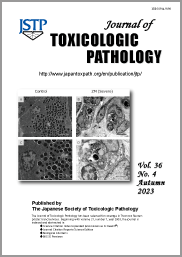
- |<
- <
- 1
- >
- >|
-
Satoshi Furukawa, Naho Tsuji, Seigo Hayashi, Yusuke Kuroda, Masayuki K ...2023Volume 36Issue 4 Pages 187-192
Published: 2023
Released on J-STAGE: October 06, 2023
Advance online publication: June 05, 2023JOURNAL OPEN ACCESSA fused triplet placenta was observed in a Wistar Hannover rat on gestation day 15. Each placenta (referred to as PL-A, PL-B, and PL-C) of this fused placenta was attached to one fetus each, but their fetal weights were lower than that of the fetus attached to the only normal placenta (referred to as PL-N) in this dam. Histopathologically, thinning of the trophoblastic septa and dilatation of the maternal sinusoid in the labyrinth zone were observed in PL-B and PL-C, but not in PL-A or PL-N. The points of placental fusion were at the junctional zone derived from each side of the placenta without connective tissues, and the septum was composed of trophoblastic giant cells. Although PL-A had a solitary metrial gland, PL-B and PL-C shared one metrial gland with one spiral artery terminus branching towards each labyrinth zone.
View full abstractDownload PDF (5991K) -
Shinya Miyazaki, Chinatsu Fujiwara, Yoshitaka Katoh, Tsuyoshi Ito, Aya ...2023Volume 36Issue 4 Pages 193-198
Published: 2023
Released on J-STAGE: October 06, 2023
Advance online publication: July 07, 2023JOURNAL OPEN ACCESSHamartomas are tumor-like masses comprising disorganized normal tissue elements. To date, spontaneous hamartomas have been reported in several organs and tissues in rodents but not in the lungs. Here, we report the first case of a hamartoma in the lungs of a 108-week-old female Wistar Hannover rat. Grossly, a white spot, 7 mm in diameter, was observed on the costal surface of the left lung. Histopathologically, the nodular lesions adjacent to the bronchioles comprised mature smooth muscle cells. The lesion was not encapsulated and spread along the alveolar walls and ducts without compression of the surrounding tissue. In the nodules, elastic fibers enclosed small lumens lined with factor VIII-related antigen-positive endothelial cells. This structure suggested that the nodule mimicked an artery. Moreover, structural abnormalities were observed within the bronchioles and arterioles owing to the increased number of smooth muscle cells in the surrounding tissues. These features suggested that this was a case of tissue malformation rather than a neoplasm, leading to the diagnosis of a smooth muscle hamartoma of the lung.
View full abstractDownload PDF (3866K)
-
Hironobu Yasuno, Yasushi Masuda, Harushige Ozaki, Tomoya Sano, Tadahir ...2023Volume 36Issue 4 Pages 199-204
Published: 2023
Released on J-STAGE: October 06, 2023
Advance online publication: May 24, 2023JOURNAL OPEN ACCESSDetermining the optimal timing for histopathological examination following exposure to a test article is crucial for assessing neurotoxicity. However, no study has focused on identifying an ideal dataset to define the optimal timing for histopathological examination of central nervous system (CNS) toxicity in monkeys. Therefore, this study aimed to define a predictive endpoint that would guide us in selecting the optimal timing for histopathological examination of CNS toxicity in monkeys. Four cynomolgus monkeys were administered 1-methyl-4-phenyl-1,2,3,6-tetrahydropyridine (MPTP) intravenously at a dosage of 0.6 mg/kg twice at 1-week intervals. Necropsies were performed 1 week after the final dose. The Parkinsonian rating (PR) score and temporal changes in neurofilament light chain and glial fibrillary acidic protein concentrations in the cerebrospinal fluid (CSF) and serum were evaluated and compared with the histopathological findings in the brain. The PR score of all animals administered MPTP increased from days 10 to 11, with some degree of individual variability. Microscopically, all animals showed axonal swelling and vacuolation, with or without microgliosis in the nigrostriatal bundle. However, substantial neurodegenerative findings were observed only in animals with high PR scores at necropsy. A slight increase in CSF biomarker levels at necropsy was also observed in animals with high PR scores. However, their correlation with microscopic findings in these animals was unclear. These data suggest that comprehensive clinical observations, such as PR score alone or combined with other CSF biomarkers, could be further evaluated as potential indicators for triggering anatomic CNS evaluations in monkeys following toxic insults.
View full abstractDownload PDF (2444K) -
Sakura Fujiwara, Takayasu Moroki, Masaya Hitomi, Makoto Sato, Yui Tera ...2023Volume 36Issue 4 Pages 205-211
Published: 2023
Released on J-STAGE: October 06, 2023
Advance online publication: July 13, 2023JOURNAL OPEN ACCESSThe pancreas plays an important role in the homeostasis of zinc (Zn), a nutritionally essential metal. In several previous studies, Zn ions induced inflammatory changes in the exocrine pancreas; however, little is known about Zn complexes. In this study, we microscopically, immunohistochemically, and ultrastructurally examined pancreatic lesions in Sprague-Dawley (SD) rats induced by a 4-week repeated oral dose toxicity study of Zinc Maltol (ZM), a zinc (II) complex. ZM induces acinar atrophy and increases the number of duct-like structures. Immunohistochemistry revealed a decrease in the number of trypsin-positive cells, and an increase in the number of SOX9-positive cells. Interstitial fibrosis and macrophage infiltration also correlated with the degree of acinar atrophy. Electron microscopic evaluation revealed that the acinar cells that lost granules were surrounded by fibroblasts and collagen fibers. In conclusion, we provided a detailed description of ZM-induced pancreatic lesions in SD rats.
View full abstractDownload PDF (3900K)
-
Shin Wakui, Masaya Motohash, Takemi Satoh, Masaru Shirai, Tomoko Mutou ...Article type: Retraction
2023Volume 36Issue 4 Pages R1-
Published: 2023
Released on J-STAGE: October 06, 2023
JOURNAL OPEN ACCESSDownload PDF (289K)
- |<
- <
- 1
- >
- >|